目的状语从句和结果状语从句学习资料
- 格式:doc
- 大小:16.50 KB
- 文档页数:2
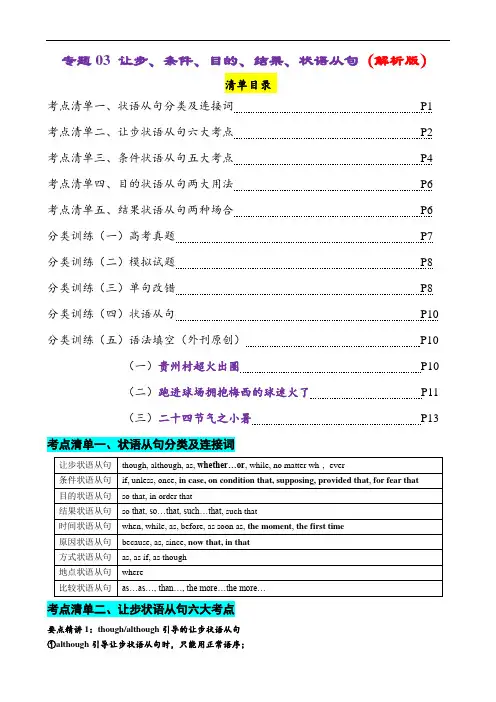
专题03 让步、条件、目的、结果、状语从句(解析版)清单目录考点清单一、状语从句分类及连接词P1 考点清单二、让步状语从句六大考点P2 考点清单三、条件状语从句五大考点P4 考点清单四、目的状语从句两大用法P6 考点清单五、结果状语从句两种场合P6 分类训练(一)高考真题P7 分类训练(二)模拟试题P8 分类训练(三)单句改错P8 分类训练(四)状语从句P10 分类训练(五)语法填空(外刊原创)P10 (一)贵州村超火出圈P10(二)跑进球场拥抱梅西的球迷火了P11(三)二十四节气之小暑P13 考点清单一、状语从句分类及连接词让步状语从句though, although, as, whether…or, while, no matter wh-, -ever条件状语从句if, unless, once, in case, on condition that,supposing, provided that, for fear that 目的状语从句so that, in order that结果状语从句so that, so…that, such…that, such that时间状语从句when, while, as, before, as soon as, the moment, the first time原因状语从句because, as, since, now that, in that方式状语从句as, as if, as though地点状语从句where比较状语从句as…as…, than…, the more…the more…考点清单二、让步状语从句六大考点要点精讲1:though/although引导的让步状语从句①although引导让步状语从句时,只能用正常语序;②though引导让步状语从句时,可用正常语序,与although替换,也可用倒装语序,与as替换。
特别③注意:although, though从句均不能与but连用。
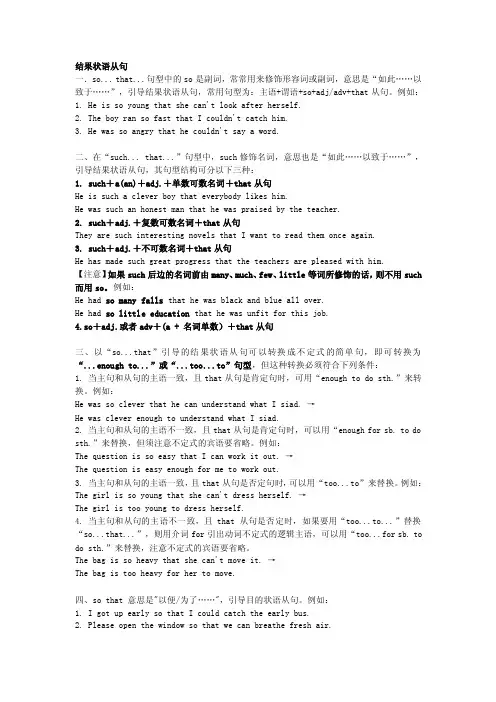
结果状语从句一.so... that...句型中的so是副词,常常用来修饰形容词或副词,意思是“如此……以致于……”,引导结果状语从句,常用句型为:主语+谓语+so+adj/adv+that从句。
例如:1. He is so young that she can't look after herself.2. The boy ran so fast that I couldn't catch him.3. He was so angry that he couldn't say a word.二、在“such... that...”句型中,such修饰名词,意思也是“如此……以致于……”,引导结果状语从句,其句型结构可分以下三种:1. such+a(an)+adj.+单数可数名词+that从句He is such a clever boy that everybody likes him.He was such an honest man that he was praised by the teacher.2. such+adj.+复数可数名词+that从句They are such interesting novels that I want to read them once again.3. such+adj.+不可数名词+that从句He has made such great progress that the teachers are pleased with him.【注意】如果such后边的名词前由many、much、few、little等词所修饰的话,则不用such 而用so。
例如:He had so many falls that he was black and blue all over.He had so little education that he was unfit for this job.4.so+adj.或者adv+(a + 名词单数)+that从句三、以“so...that”引导的结果状语从句可以转换成不定式的简单句,即可转换为“...enough to...”或“...too...to”句型,但这种转换必须符合下列条件:1. 当主句和从句的主语一致,且that从句是肯定句时,可用“enough to do sth.”来转换。

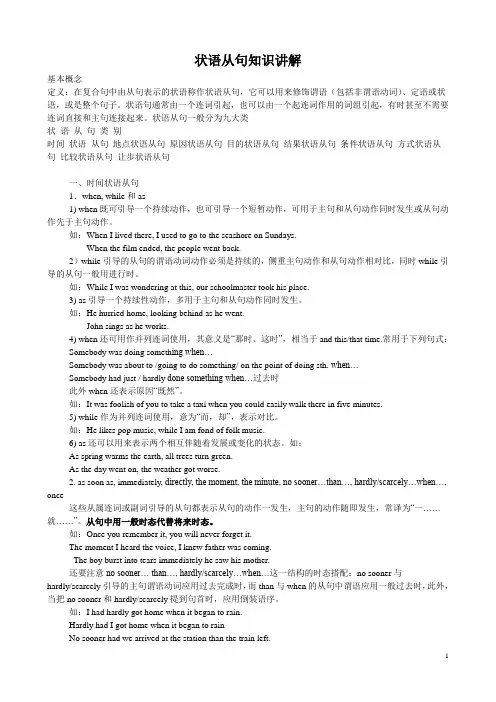
状语从句知识讲解基本概念定义:在复合句中由从句表示的状语称作状语从句,它可以用来修饰谓语(包括非谓语动词)、定语或状语,或是整个句子。
状语句通常由一个连词引起,也可以由一个起连词作用的词组引起,有时甚至不需要连词直接和主句连接起来。
状语从句一般分为九大类状语从句类别时间状语从句地点状语从句原因状语从句目的状语从句结果状语从句条件状语从句方式状语从句比较状语从句让步状语从句一、时间状语从句1.when, while和as1) when既可引导一个持续动作,也可引导一个短暂动作,可用于主句和从句动作同时发生或从句动作先于主句动作。
如:When I lived there, I used to go to the seashore on Sundays.When the film ended, the people went back.2)while引导的从句的谓语动词动作必须是持续的,侧重主句动作和从句动作相对比,同时while引导的从句一般用进行时。
如:While I was wondering at this, our schoolmaster took his place.3) as引导一个持续性动作,多用于主句和从句动作同时发生。
如:He hurried home, looking behind as he went.John sings as he works.4) when还可用作并列连词使用,其意义是“那时、这时”,相当于and this/that time.常用于下列句式:Somebody was doing someth ing when…Somebody was about to /going to do something/ on the point of doing sth. when…Somebody had just / hardly done something when…过去时此外when还表示原因“既然”。
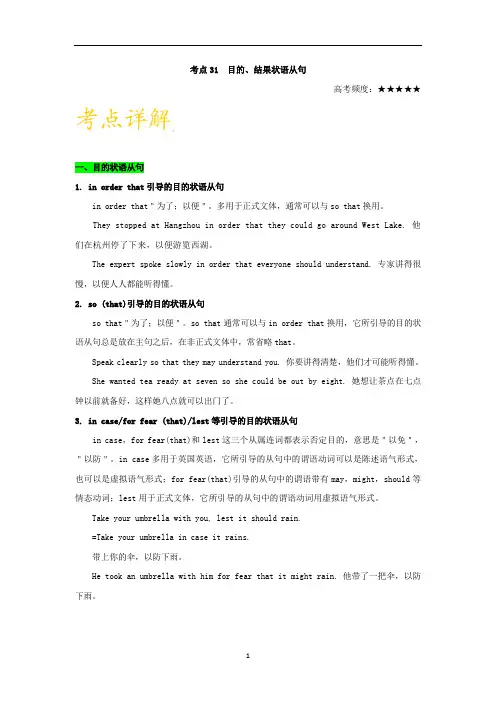
考点31 目的、结果状语从句高考频度:★★★★★一、目的状语从句1. in order that引导的目的状语从句in order that"为了;以便"。
多用于正式文体,通常可以与so that换用。
They stopped at Hangzhou in order that they could go around West Lake. 他们在杭州停了下来,以便游览西湖。
The expert spoke slowly in order that everyone should understand. 专家讲得很慢,以便人人都能听得懂。
2. so (that)引导的目的状语从句so that"为了;以便"。
so that通常可以与in order that换用,它所引导的目的状语从句总是放在主句之后,在非正式文体中,常省略that。
Speak clearly so that they may understand you. 你要讲得清楚,他们才可能听得懂。
She wanted tea ready at seven so she could be out by eight. 她想让茶点在七点钟以前就备好,这样她八点就可以出门了。
3. in case/for fear (that)/lest等引导的目的状语从句in case,for fear(that)和lest这三个从属连词都表示否定目的,意思是"以免","以防"。
in case多用于英国英语,它所引导的从句中的谓语动词可以是陈述语气形式,也可以是虚拟语气形式;for fear(that)引导的从句中的谓语带有may,might,should等情态动词;lest用于正式文体,它所引导的从句中的谓语动词用虚拟语气形式。
Take your umbrella with you, lest it should rain.=Take your umbrella in case it rains.带上你的伞,以防下雨。
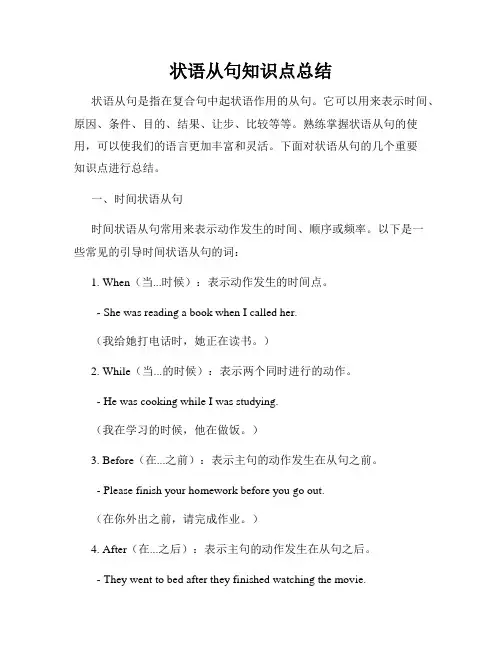
状语从句知识点总结状语从句是指在复合句中起状语作用的从句。
它可以用来表示时间、原因、条件、目的、结果、让步、比较等等。
熟练掌握状语从句的使用,可以使我们的语言更加丰富和灵活。
下面对状语从句的几个重要知识点进行总结。
一、时间状语从句时间状语从句常用来表示动作发生的时间、顺序或频率。
以下是一些常见的引导时间状语从句的词:1. When(当...时候):表示动作发生的时间点。
- She was reading a book when I called her.(我给她打电话时,她正在读书。
)2. While(当...的时候):表示两个同时进行的动作。
- He was cooking while I was studying.(我在学习的时候,他在做饭。
)3. Before(在...之前):表示主句的动作发生在从句之前。
- Please finish your homework before you go out.(在你外出之前,请完成作业。
)4. After(在...之后):表示主句的动作发生在从句之后。
- They went to bed after they finished watching the movie.(他们在看完电影之后就去睡觉了。
)二、原因状语从句原因状语从句常用来表示某个动作的原因或理由。
以下是一些常见的引导原因状语从句的词:1. Because(因为):表示直接的原因。
- I didn't go to the party because I was tired.(我因为累所以没有参加聚会。
)2. Since(因为):表示已知的事实或理由。
- He was absent from work since he was not feeling well.(他因病缺勤了。
)3. As(因为):表示两个动作同时发生,前者是后者发生的原因。
- I couldn't hear the speaker as the music was too loud.(由于音乐声音太大,我听不到演讲者的声音。
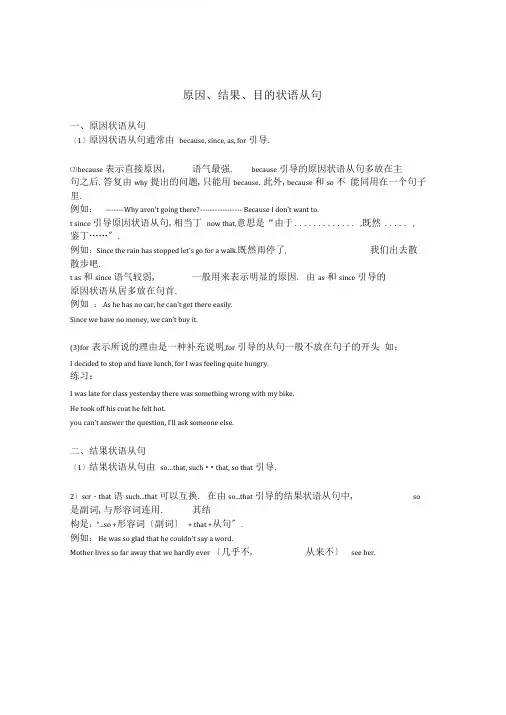
原因、结果、目的状语从句一、原因状语从句〔1〕原因状语从句通常由because, since, as, for引导.⑵because表示直接原因, 语气最强. because引导的原因状语从句多放在主句之后.答复由why提出的问题,只能用because.此外,because和so不能同用在一个句子里.例如:------- W hy aren't going there? ----------------- Because I don't want to.t since引导原因状语从句,相当丁now that,意思是“由于............. ,既然 ..... ,鉴丁……〞.例如:Since the rain has stopped let's go for a walk.既然雨停了, 我们出去散散步吧.t as和since语气较弱, 一般用来表示明显的原因. 由as和since引导的原因状语从居多放在句首.例如: As he has no car, he can't get there easily.Since we have no money, we can't buy it.(3)for表示所说的理由是一种补充说明,for引导的从句一般不放在句子的开头如:I decided to stop and have lunch, for I was feeling quite hungry.练习:I was late for class yesterday there was something wrong with my bike.He took off his coat he felt hot.you can't answer the question, I'll ask someone else.二、结果状语从句〔1〕结果状语从句由so…that, such •• that, so that引导.2〕scr・that语such...that可以互换. 在由so...that引导的结果状语从句中, so 是副词,与形容词连用. 其结构是:“...so +形容词〔副词〕+ that +从句〞.例如: He was so glad that he couldn't say a word.Mother lives so far away that we hardly ever 〔几乎不, 从来不〕see her.t 在由such・・・that引导的结果状语从句中, such是形容词, 它修饰的可以是单数或复数可数名词, 也可以是不可数名词;其结构是:“...such+a / an +形容词+名词+ that +从句〞.例如: It was such a hot day that nobody wanted to do anything.He had such long arms that he could almost touch the ceiling(天花板)T有时上述两种结构是可以互换的.例如: It was such a wonderful film that all of us wanted to see it again.=The film was so wonderful that all of us wanted to see it again.⑶如果名词前由many, much, little, few等词修饰时, 只能用so,不用such.例如: Soon there were so many deer that they ate up all the wild roses.He has so little time that he can't go to the cinema with you.(4)如果主从句的主语相同, 并且从句是否认的形式, 可以用too...to...句型转化.例如: He was so excited that he couldn't go to sleep that night. = He was too excited to go to sleep.(5)如果主从句的主语相同, 但从句是肯定的形式, 可以用adj.+ enough替换.例如: He is so old that he could go to school. = He is old enough to go to school 够大了,可以去上学.练习: It is hot in the room we have to go out for a walk.It was a wonderful movie all of us wanted to see it again.There were little water in the bottle the bird couldn't reach it.【练习】用scr that… 或者such ••that…填空:1.It was hot in the cinema ______________________________ I felt very uncomfortable.2.It was a funny film I laughed until I cried!3.few people came to see the film _________________ the manager put on another filminstead.4.Tom hurt his legs badly he was not able to walk for six months.5.There were many people at the party _______________________________ o ur house got too crowded.6.Joy has a strong love of films she goes to the cinema every week..三、目的状语从句(1)目的状语从句通常由so that, in order that (为了, 以便) 引导.例如: We started early so that we could catch the first train.We used the computer in order that we might save time.(2)so that可引导目的状语从句,此时可用to或in order to替换,将其改为简单句.例如:He got up early so that he could get to school on time.=He got up early (in order) to get to school on time.(3)so that既可引导目的状语从句, 乂可引导结果状语从句. 区别这两种从句的方法有两个:1)目的状语从句里往往带有情态动词can, could, may, might等.2)从意思上看, 目的状语从句往往表示的目的很明确.例如:Speak clearly so that they may understand youj| 的状语从句)Jack is badly ill so that he has to rest.结果状语从句)练习:I hurried I wouldn't be late for class.We should go by bus we can get there earlier.May I sit nearer I can see more clearly?(4)补充:so as to・・(肯定结构)eg. He got up early so as to catch the early train.so as not to・・(否认结构)eg. He got up early so as not to miss the early train.to… eg. He got up early to catch the early train.in order that ••- eg. He got up early in order that he could catch the early train.in order to… eg. He got up early in order to catch the early train.【练习】-、单项选择1. We'll stay at home if it _ ________ t omorrow.A. rainB. rainsC. is rainingD. will rain2. We didn't go home_____________________________________ -we finished the workA. sinceB. untilC. becauseD. though3. She _____________ w hen I went to see her.A. is readingA. BeforeB. UnlessC. As soon asD. Though5. She looks forward every spring t the flower-lined garden.A. visitB. paying a visitC. walk inD. walking in6. Mr. White hoped he China the next year.A. would visitB.will visit C.visited D.has visited 7.I told him that the sun in the east. A.rises B.rose C.has risen D.was rising 8.She was tired she could not move an inch. A. so, thatB. such, thatC. very, thatD. so, as9. He was sentenced to death what he had stolen from the bank.A. thatB. sinceC. becauseD. because of10. I didn't know what.A. was the matterB. is the matterC. the matter wasD. the matter is11. I couldn't agree with at the meeting.A. that you saidB.C.D.4.have read was reading reads the rain stops, we'll set off for the station.B. which you saidC. what did you sayD. what you said12. The bad man ran away to avoid ________________________ and was finally put into prison.A. seeingB. to be seen C being seenD. to be caught13. Everyone except Jim and Jack .A. know who is heB. know who he isC. knows who is heD. knows who he is15. It is ten years _______________ I left my hometown.A. sinceB. IfC. whetherD. until16. Could you tell us __________________ M r. Brown lives in Room 202 ?A. thatB. whereC. untilD. if17. I learned a little Russian _________________ I was at middle school.A. thoughB. althoughC. as ifD. when18. I don't know ______________ or not it will rain tomorrow.A. thatB. WhenC. ifD. whether19. —Why is their classroom so clean and tidy — _______________________________ i t is cleaned every dayA. SinceB. AsC. BecauseD. For20. Can you tell me _________________ i s going to give us a talk next Monday?A. whoB. whomC. whoseD. what21.Please answer the question in a loud enough voice all the class may hear.A.so, thatB.orC. in order thatD. and22.Lift it up I may see it.A.thoughB.so thatC.asD.than。
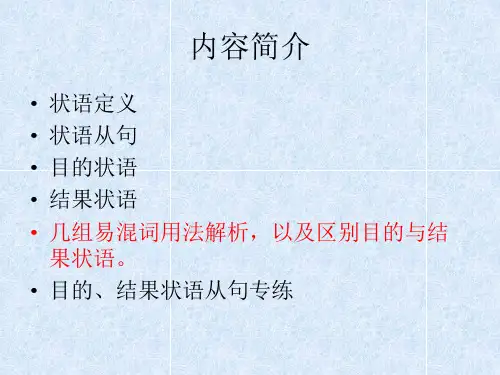
内容简介•状语定义•状语从句•目的状语•结果状语•几组易混词用法解析,以及区别目的与结果状语。
•目的、结果状语从句专练the Adverbial状语句子+引导词作状语。
修饰动词、形容词、副词或整个句子,说明动作或状态特征的句子成分,叫做状语。
Revision ofthe Adverbial Clauses状语从句状语从句(Adverbial Clause)状语从句指句子用作状语时,起副词作用的句子。
它可以修饰谓语、非谓语动词、定语、状语或整个句子。
九种状从(按作用分)时间状语从句地点状语从句原因状语从句条件状语从句让步状语从句结果状语从句目的状语从句方式状语从句比较状语从句目的状语Adverbial clauses of purpose 目的状语从句:从句部分是用以补充说明主句中谓语动词发生的目的。
目的状语从句主要由in order that, so that, for fear that, in case,lest引导,也可以由in order (not)to ,so as (not) to等和动词不定式短语共同充当。
由that, so that(以便), in order that(目的是为了….), in case, for fear that(生怕)引导的目的状语从句中的位于部分需含情态动词may(might),can(could), shall(should),will(would)等。
eg; The teacher spoke slowly so that we could understandbetter.eg; He works hard in order that he can serve his country well.由in case , for fear that, lest(以防)引导的状语从句中,动词可以用虚拟语气,形式为should +动词原形,也可以不用,用动词的一般现在时或一般过去时。
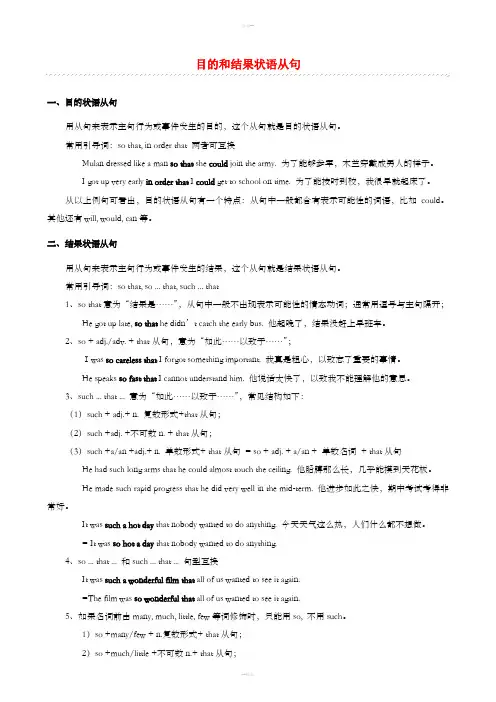
目的和结果状语从句一、目的状语从句用从句来表示主句行为或事件发生的目的,这个从句就是目的状语从句。
常用引导词:so that, in order that 两者可互换Mulan dressed like a man so that she could join the army. 为了能够参军,木兰穿戴成男人的样子。
I got up very early in order that I could get to school on time. 为了能按时到校,我很早就起床了。
从以上例句可看出,目的状语从句有一个特点:从句中一般都含有表示可能性的词语,比如could。
其他还有will, would, can等。
二、结果状语从句用从句来表示主句行为或事件发生的结果,这个从句就是结果状语从句。
常用引导词:so that, so ... that, such ... that1、so that意为“结果是……”,从句中一般不出现表示可能性的情态动词;通常用逗号与主句隔开;He got up late, so that he didn’t catch the early bus. 他起晚了,结果没赶上早班车。
2、so + adj./adv. + that从句,意为“如此……以致于……”;Iwas so careless that I forgot something important. 我真是粗心,以致忘了重要的事情。
He speaks so fast that I cannot understand him. 他说话太快了,以致我不能理解他的意思。
3、such ... that ... 意为“如此……以致于……”,常见结构如下:(1)such + adj.+ n. 复数形式+that从句;(2)such +adj. +不可数n. + that从句;(3)such +a/an +adj.+ n. 单数形式+ that从句= so + adj. + a/an + 单数名词+ that从句He had such long arms that he could almost touch the ceiling. 他胳膊那么长,几乎能摸到天花板。
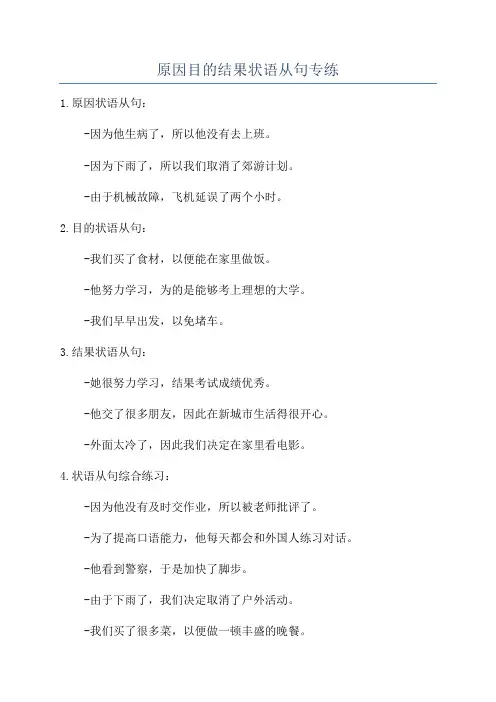
原因目的结果状语从句专练1.原因状语从句:
-因为他生病了,所以他没有去上班。
-因为下雨了,所以我们取消了郊游计划。
-由于机械故障,飞机延误了两个小时。
2.目的状语从句:
-我们买了食材,以便能在家里做饭。
-他努力学习,为的是能够考上理想的大学。
-我们早早出发,以免堵车。
3.结果状语从句:
-她很努力学习,结果考试成绩优秀。
-他交了很多朋友,因此在新城市生活得很开心。
-外面太冷了,因此我们决定在家里看电影。
4.状语从句综合练习:
-因为他没有及时交作业,所以被老师批评了。
-为了提高口语能力,他每天都会和外国人练习对话。
-他看到警察,于是加快了脚步。
-由于下雨了,我们决定取消了户外活动。
-我们买了很多菜,以便做一顿丰盛的晚餐。
-她学习很努力,结果考试得了满分。
-妈妈担心我走夜路不安全,所以每天都来接我放学。
-我们计划早早出发,以免迟到。
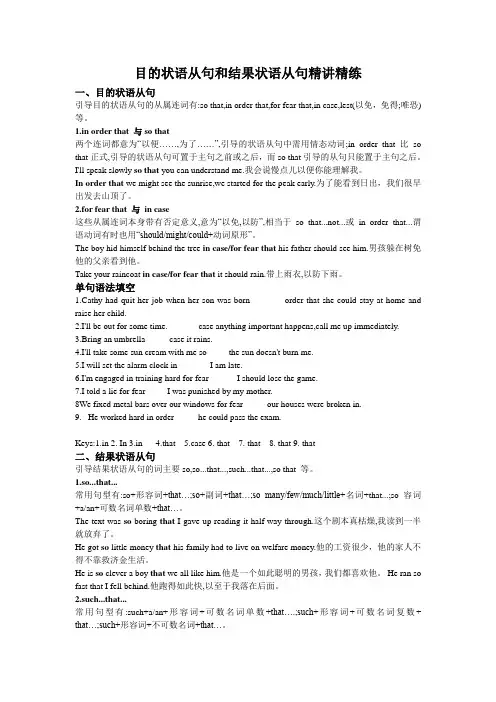
目的状语从句和结果状语从句精讲精练一、目的状语从句引导目的状语从句的从属连词有:so that,in order that,for fear that,in case,lest(以免,免得;唯恐)等。
1.in order that 与so that两个连词都意为“以便……,为了……”,引导的状语从句中需用情态动词;in order that 比so that正式,引导的状语从句可置于主句之前或之后,而so that引导的从句只能置于主句之后。
I'll speak slowly so that you can understand me.我会说慢点儿以便你能理解我。
In order that we might see the sunrise,we started for the peak early.为了能看到日出,我们很早出发去山顶了。
2.for fear that 与in case这些从属连词本身带有否定意义,意为“以免,以防”,相当于so that...not...或in order that...谓语动词有时也用“should/might/could+动词原形”。
The boy hid himself behind the tree in case/for fear that his father should see him.男孩躲在树免他的父亲看到他。
Take your raincoat in case/for fear that it should rain.带上雨衣,以防下雨。
单句语法填空1.Cathy had quit her job when her son was born______ order that she could stay at home and raise her child.2.I'll be out for some time._______case anything important happens,call me up immediately.3.Bring an umbrella _____case it rains.4.I'll take some sun cream with me so_____the sun doesn't burn me.5.I will set the alarm clock in _______I am late.6.I'm engaged in training hard for fear ______I should lose the game.7.I told a lie for fear_____I was punished by my mother.8We fixed metal bars over our windows for fear _____our houses were broken in.9.He worked hard in order _____he could pass the exam.Keys:1.in 2. In 3.in 4.that 5.case 6. that 7. that 8. that 9. that二、结果状语从句引导结果状语从句的词主要so,so...that...,such...that...,so that 等。
知识点名:状语从句(目的、结果)讲义:一、目的状语从句so that和in order that引导目的状语从句时,表示“以便;为了”,从句中常使用can /could /may /might /will /would /should 等情态动词。
例:He gets up early so that he can catch the first bus.他早早起床是为了能赶上第一班公共汽车。
当主句和从句的主语一致时,从句通常可以写成so as to do sth. 或in order to do sth.结构。
例:They both worked day and night in order that they could pay off their debt.They both worked day and night in order to pay off their debt.他们夜以继日地工作以便能把债还清。
二、结果状语从句结果状语从句的常用句型如下:so+ adj. / adv. + thatso + adj.+ a / an +可数名词单数+ thatso many / much / little / few+名词+ thatsuch + a / an + adj.+可数名词单数+ thatsuch + adj.+可数名词复数/不可数名词+ that,如:He is so clever that almost everyone likes him.=He is so clever a boy that almost everyone likes him.他如此聪明以至于几乎每个人都喜欢他。
He is such a clever boy that almost everyone likes him.他是如此聪明的一个男孩儿以至于几乎每个人都喜欢他。
It is such fine weather that we all want to go out for a walk.天气这么好,我们都想出去走走。
目的与结果状语从句1,目的状语从句常见引导词主要有:so that, in order that。
从句中常含有情态动词will / would 或can / could。
I turned off the TV so that my roommate could study in peace and quiet.We climbed high so that we could get a better view.They carved the words on the stone i n order that the future generation would remember what they had done.2, 结果状语从句常见的连接词主要有:so …that, such…that, 从句中一般不带情态动词,且从句都要放在主句后。
The food is so bad in the school cafeteria that flies go there to lose weight.3, 注意下句中such 和so 的用法区别:so 后面直接加形容词,such要先接冠词a(n)a.He is such a good teacher that everyone likes him.b.He is so good a teacher that everyone likes him.such可修饰不可数名词,so 不可:c. It was such nice weather that we went to the beach.或者d. The weather was so nice that we went to the beach.such可修饰复数名词,so 不可:e. He got such heavy boxes that he couldn’t carry them by himself.so 可与many, much, few, little搭配,such不可:f. I made so many mistakes that I failed the exam.g.He has so few friends that he is always lonely.h. He lost so much money that he didn’t dare to go home.i. I had so little trouble with the test that I left half an hour early.。
结果状语从句结果状语从句常由so… that 或such…that引导,掌握这两个句型,首先要了解so 和 such与其后的词的搭配规律。
比较: so和 such其规律由so与such的不同词性决定。
such 是形容词,修饰名词或名词词组,so 是副词,只能修饰形容词或副词。
so 还可与表示数量的形容词many, few, much, little 连用,形成固定搭配。
so foolish such a foolso nice a flower such a nice flowerso many / few flowers such nice flowersso much / little money. such rapid progressso many people such a lot of people( so many 已成固定搭配,a lot of 虽相当于 many,但 a lot of 为名词性的,只能用such搭配。
)so…that与such…that之间的转换既为 so与such之间的转换。
The boy is so young that he can't go to school.He is such a young boy that he can't go to school[编辑本段]考题解析[考题1] Pop music is such an important part of society ____ it has even influence our language. (2007上海)A. asB. thatC. whichD. where[答案] B[解析]下划线处之后表示结果,应选用与前面的such连用引导结果状语从句的that。
[考题2] His plan was such a good one ____ we all agreed to accept it. (2006陕西)A. soB. andC. thatD. as[答案] C[解析] that与前面的such呼应,引导结果状语从句。
初中英语原因目的和结果状语从句详解原因状语从句(Adverbial clause of reason)是表示一个动作或情况的原因或理由的从句。
目的状语从句(Adverbial clause of purpose)是表示一个动作或情况的目的或意图的从句。
结果状语从句(Adverbial clause of result)是表示一个动作或情况的结果或后果的从句。
详细解释如下:1. 原因状语从句(Adverbial clause of reason):原因状语从句回答“为什么?”的问题,说明动作或情况的原因或理由。
原因状语从句通常由连词because、since、as、now that、seeing that等引导。
例句:- I couldn't sleep because it was too noisy.(我不能入睡,因为太吵了。
)- Since it was raining heavily, we stayed indoors.(由于下着大雨,我们呆在室内。
)2. 目的状语从句(Adverbial clause of purpose):目的状语从句回答“为了什么?”的问题,说明动作或情况的目的或意图。
目的状语从句通常由连词so that、in order that、for the purpose of等引导。
例句:- I study hard so that I can get good grades.(我努力学习,以便能取得好成绩。
)- I bought a ticket for the concert so that I could see my favorite singer.(我买了一张音乐会的票,为了能看到我最喜欢的歌手。
)3. 结果状语从句(Adverbial clause of result):结果状语从句回答“怎么样?”的问题,说明动作或情况的结果或后果。
结果状语从句通常由连词so、such...that、enough等引导。
目的状语和结果状语从句一、目的状语从句引导目的状语从句的从属连词有:so that, in order that, for fear that, in case, lest等。
1.In irder that与so that两个连词都意为“以便…..;为了….”,引导的状语从句中需用情态动词,in order that比sothat正式,引导的状语从句可置于主句之前或之后,而so that引导的从句只能置于主句之后。
My father declared he was going to buy a new plot(小块土地)in a cornerof the cemetery(墓地)so that he could get out easier.父亲声明他要在墓地角上买一块儿新墓地,这样他出去容易些!注:热爱自由的父亲被母亲管得太严了,老是不让出门,他希望死后会有所改观。
The right hand must wash the left so that both can be clean.左手洗右手,双手才干净。
2.For fear that, in case与lest这些从属连词引导的目的状语从句中位于动词要用(should +)动词原形,它本身带有否定意义,相当于so that....not (i)order that…not….。
场景再现:晚饭后爸爸带这小女儿Mary去散步,临走时,女儿对爸爸说:Daddy, please take some chocolates with you in case I cry on theway.爸爸,请带上点儿巧克力以防我在路上哭闹。
When you do a good deed, get a receipt[收据], in case heaven is likethe IRS(税务系统)。
做了好事,要拿到收据,万一天堂也象税务局一样呢。
注:拿着收据到上帝那请功去。
四、目的状语从句
在句中作目的状语的从句称为目的状语从句。
常用来引导目的状语从句的有:so,so that,in order that,for fear that,in case(that),for the purpose that,lest等。
目的状语从句可置于句首,句中或句尾,且从句中常有情态动词could,might,should等。
1、in order that,so that 引导的目的状语从句
in order that常用于正式文体,可置于句首,也可置于句尾,而so that往往只置于句尾,但也有置于句首的,so that短语中有时可省略that。
They carved the words on the stone so that/in order that the future generation should/might remember what they had done.
他们把字刻在石头上以便后代能记住他们的所作所为。
特别提示!:当so that,in order that引导的目的状语从句中的主语与主句主语一致时,可将状语从句简化为不定式作状语。
如果主语不一致,转化时则需在不定式前加for短语作其逻辑主语。
上面的例句可改为:
They carved the words on the stone in order for the future generation to remember what they had done.
2、for fear (that),in case,lest引导的目的状语从句
for fear that表示目的时,意为“唯恐,以防”,in case意为“目的是,以防”,lest意为“以防”
Take an umbrella with you lest/in case it should rain.带着伞以防下雨。
五、结果状语从句
在句中作结果状语的从句称为结果状语从句,结果状语从句一般置于句尾。
常用来引导结果状语从句的词或短语有:that , so, so that ,so ```that ```等
1、so that与so···that···引导的结果状语从句
①、so that引导的结果状语从句
It was dark,so that we could see nothing in front of us.
天很黑,我们看不见前面的任何东西。
②、so···that···引导的结果状语从句
so···that···引导的结果状语状语从句可以构成如下结构
形容词或副词
many/few(+可数名词复数)
so+ much/little(+不可数名词) +(that)+从句
形容词+a/an+可数名词复数
Kathy is so lovely that we all like to play with her.
凯西很可爱,我们都愿和她玩。
2、such···that···引导的结果状语从句
such···that···引导结果状语从句,可以构成如下结构:
a/an +形容词+可数名词复数
such+ 形容词+可数名词复数+(that)+从句
形容词+不可数名词
Kathy is such lovely girl that we all like to play with her.
凯西很可爱,我们都愿和她玩。
特别提示!:为了强调形容词或副词,so/such···that···引导的结果状语从句,可把so/such部分置于句首,主语用倒装语序。
So excited was he that he could not fall into sleep.
他太激动不能入睡。
3、that引导的结果状语从句
What have we done that you should be so angry with us?
我们做了什么使你这么生气?。